 Adelaide Oval, Australia, 2003. India trailing by a good 471 runs catching up with the Australian first innings score of 556. As a result of a mix up and a run out, the fourth wicket goes down in the form of Sourav Ganguly. Geoffery Boycott screams on commentary “That was so STYUUPID of Dravid” to have sent him back halfway through from the crease. They said he will regret sending back his own captain back to the pavilion. They said the mistake will put him under pressure. The scorecard read 85/4… Pressure. More pressure. But what followed is, as they say, history. An innings of 233 followed by an equally well made 72 in the second innings, gave India its first Test win on Aussie soil in 22 years.
Adelaide Oval, Australia, 2003. India trailing by a good 471 runs catching up with the Australian first innings score of 556. As a result of a mix up and a run out, the fourth wicket goes down in the form of Sourav Ganguly. Geoffery Boycott screams on commentary “That was so STYUUPID of Dravid” to have sent him back halfway through from the crease. They said he will regret sending back his own captain back to the pavilion. They said the mistake will put him under pressure. The scorecard read 85/4… Pressure. More pressure. But what followed is, as they say, history. An innings of 233 followed by an equally well made 72 in the second innings, gave India its first Test win on Aussie soil in 22 years.
It is what ‘The Wall’ had done all through his career with such regularity that it is difficult to count his stand out performances for his team. Kolkata 2001 has become part of cricketing folklore. In England earlier this season, where India didn’t seem to have any answer to the English seam bowling attack, this man stood out, piling on hundreds. No matter what the start, as long as he was at the crease, a dressing room and an entire nation would breathe easy. That’s what a Mr. Dependable does to you, doesn’t he?
Such was his technique that usage of the word ‘copy book’ in the commentary box became a ritual every time he played a shot. He concentrated on the basics, and boy, would he ‘concentrate’. He wasn’t a Sehwag who demoralises a bowler in a matter of minutes, smashing him all over the park. He had his own way of demoralisation… Tap. Tap. Tap. Tap. Tap. and Tap. and Tap. and Tap… and pounce on the bowler’s error with grace. Not to forget the number of catches he has taken at slips, concentrating literally every single delivery bowled in an entire day’s play. He isn’t the second most leading run scorer in the history of the game for no reason. With 13,288 runs that he accumulated throughout his career, he falls just 2,182 runs short of Tendulkar, who is currently the leading run scorer in Tests.

Scoring that many runs in a Test career that began in 1996, i.e. after seven years since Tendulkar started playing, is an achievement many tend to ignore. In fact, many claim that Dravid did not get the recognition he deserved as Tendulkar would be accorded limelight more often, pretty much the way Sunil Gavaskar would take away limelight from the gracious Gundappa Vishwanath. But Dravid doesn’t complain. He never has.
For him, it was Team India that was more important. He would open if the team wanted him to. They asked him to keep wickets and he did it. Who can forget that diving catch that he took behind the stumps to dismiss Abdur Razzak in that pressure match against Pakistan during the 2003 World Cup? Not to forget his three consecutive sixes in his lone T20 that he played for India against England – something that he is not associated with…Anything for the team, anything.
He may have been perceived ‘boring’ all through. He may not have been part of the World Cup winning side. But he will always be remembered for his grit, technique, humbleness and above all dedication for the cause of the team. He is a ‘copy book’ that can never have a Xerox copy.






Comments
Add new comment